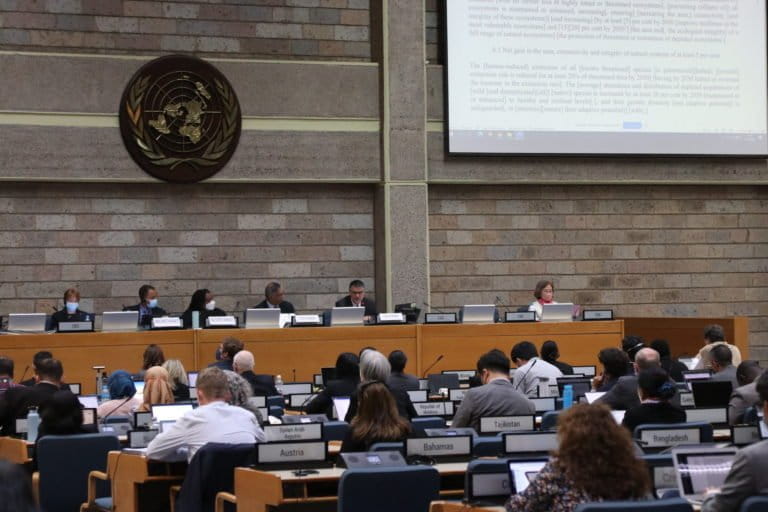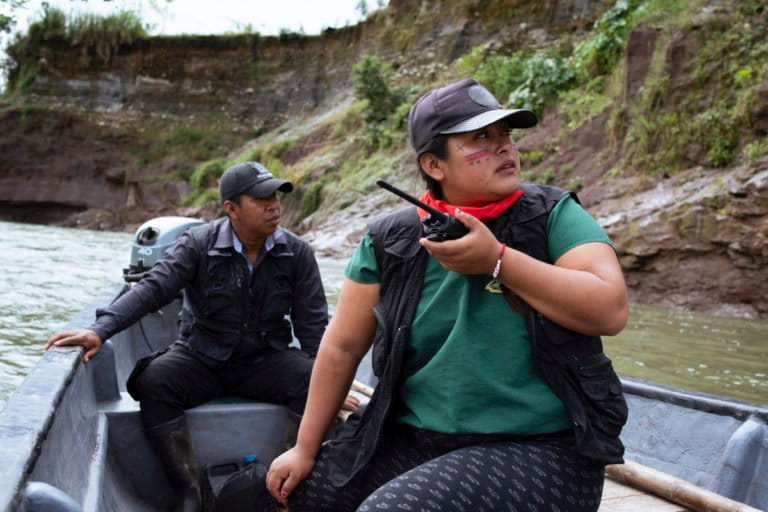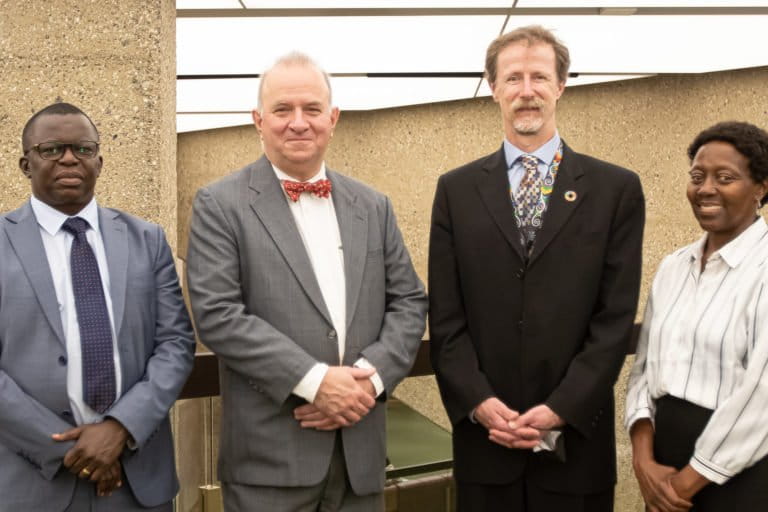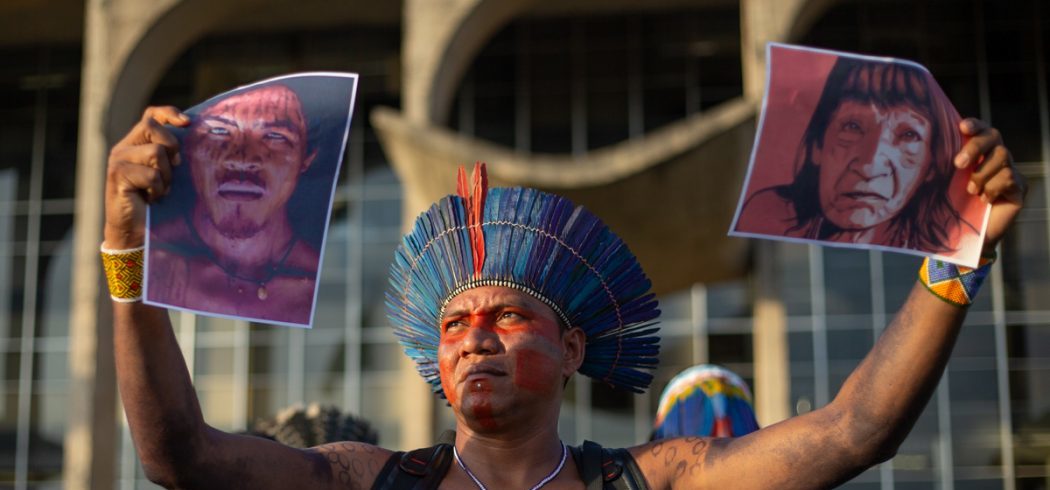- Negotiation talks in Nairobi, Kenya, for the new global agreement to preserve and protect nature ended last week, but parties have not yet come to an agreement over the final draft – including proposals laid out by the International Indigenous Forum on Biodiversity (IIFB).
- Disappointed by the progress made at the latest biodiversity meeting after two years of talks, Indigenous leaders and civil society organizations are urging parties to secure land rights, include monitoring components and strengthen the text’s language around their role in meeting biodiversity goals.
- The inclusion of gender equality and environmental defenders in the text, and their access to justice, is seen as a win for Indigenous people, women and environmental defenders. Some proposals by the IIFB are still held within the draft, though several areas are in square brackets.
- The final agreement is set to be adopted in Montreal in December, but at least one more round of negotiations is expected to take place before then. Dates are yet to be determined.
Finalizing the new Global Biodiversity Framework (GBF) is taking longer than expected and yet another round of negotiations – this time in Nairobi, Kenya – ended without much progress, say members of the International Indigenous Forum on Biodiversity (IIFB).
Indigenous leaders part of the fourth working group meeting are disappointed that the inclusion of language recognizing Indigenous and traditional territories in the final GBF is still up for debate after years of negotiations – as is majority of the IIFB’s proposals.

Negotiations for the new global agreement to preserve and protect nature were supposed to be finalized in 2020 but faced delays due to the COVID-19 pandemic. The first official draft was released in July 2021 and was expected to undergo further refinement for a final meeting in spring 2022 but faced more debates and pandemic-related restrictions in the host country, China. A final agreement is now set to take place at COP15 in December in Montreal, Canada.
In preparation for these final talks, government officials from 195 countries, Indigenous leaders and civil society organizations met in Nairobi last week to discuss the draft.
Securing land rights and strengthening the text’s language to recognize Indigenous peoples and local communities (IPLCs) as ‘stakeholders’ or ‘vital actors’ rather than ‘participants’ is seen by its proponents as critical to achieving the goals and targets of the GBF.
“Despite strong evidence of the role played by IPLCs in the conservation and sustainable use of biological diversity and the mitigation and adaptation to climate change, many of IPLC proposals in the GBF remain in square brackets,” said IIFB in a statement. Text in square brackets is seen as optional or is up for discussion.
“We strongly urge parties to lift the brackets from the text proposed by Indigenous peoples and local communities,” says Ramiro Batzin, Co-Chair of the IIFB.

‘30 by 30’ target still up for debate
The recognition of the contribution of IPLCs in achieving the ‘30 by 30’ conservation target, also known as target 3 of the GFB, is still up for debate. The aim of 30 by 30 is to protect 30% of the world’s oceans and land by 2030.
Its proponents, including many of the world’s largest conservation NGOs, say such protective measures would provide a lifeline for species struggling amid the global biodiversity crisis. However, many Indigenous leaders and human rights advocates say this goal may lead to the mass eviction of Indigenous and local communities for the creation of more protected areas.
Indigenous peoples’ customary territories are estimated to contain 36% of the world’s remaining intact forest landscapes and 80% of remaining biodiversity.
The first draft GBF targets contained no effective safeguards to protect the lands, rights and livelihoods of IPLCs in conservation programs or protected areas, say Indigenous leaders. Since then, Indigenous groups have been calling for the full recognition of their rights over their lands, waters, and territories within the GBF.

Area-based conservation and the protection of key bioregions such as the Amazon basin, the Congo basin and the tropical rainforests of Southeast Asia should form a core part of the framework, said Indigenous leaders in the Nairobi meeting, but it should not come at the exclusion of Indigenous land rights.
“Indigenous peoples don’t see nature as separate from people, and neither should the Global Biodiversity Framework,” said Joji Carino, member of the IIFB, while speaking during at a meeting. “Governments can no longer treat biodiversity and humans as separate if we are to really reach an agreement [in Montreal]. We are so closely interrelated.”
The proposal that the free, prior, and informed consent of IPLCs must be respected regarding the establishment of protected areas are among several issues still to be resolved, says Viviana Figuero, a representative of IIFB and Indigenous Women’s Network on Biodiversity for the Latin American and Caribbean region.
“Many parties wanted to move our proposals to a section that has no monitoring components,” she says.
The text in the 30 by 30 target also needs to be adjusted to provide clear guidance on traditional territories and lands, says Joseph Itongwa Mukumo, the national executive director for ANAPAC in the Democratic Republic of Congo (DRC).
To strengthen traditional biodiversity conservation efforts and the implementation of the GBF, Mukumo says Indigenous need direct access to funding. These are among the areas that need to be addressed by final discussions in December.

IIFB believes that a human rights-based approach would make the GBF effective, transformative, and consistent with the U.N. Declaration on the Rights of Indigenous Peoples and other international human rights laws.
A U.N. report found that supporting and empowering IPLCs is one of the most cost-effective responses in protecting biodiversity and tackling carbon emissions.
“The framework should therefore promote Indigenous land tenure in order to improve conditions for their forest management and provide greater protection against outside threats,” says Jaeger.
A sense of urgency
Although the GBF may finally be adopted in Montreal in December, at least one more round of negotiations is expected to take place before then. Dates are yet to be determined.
“It’s frustrating that the urgency is not there. We are spending hours talking about what is the right word to use, what is the right punctuation to use, while people in Loliondo [Tanzania] get killed,” Jennifer Corpuz, Global Policy and Advocacy lead for Nia Tero tells Mongabay.
“How can we debate whether to use ‘seas’ or ‘oceans’ when people are getting killed in the name of conservation?” asks Corpuz.
Maurizo Farhan Ferrari, senior policy officer at Forest Peoples Programme (FPP), tells Mongabay that despite the lack of progress, the organization still believes that final negotiations in December will produce the GBF.
He notes that some proposals by IIFB are still included in the draft, although several areas are bracketed, still making it a win for IPLCs.

In meetings, Indigenous leaders noted that a lack of land tenure has led to threats and murders of environmental defenders – an act that has increased over the past few years. Indigenous people make up a third of the total number of environmental defenders killed across the globe, despite being a total of 4% of the world’s population, according to a report by Global Witness.
The inclusion of gender equality and environmental defenders in the text, and their access to justice, is seen as a win for IPLCs, women and environmental defenders.
While speaking to Mongabay, the IIFB reaffirmed its commitment to work with stakeholders to increase national ambitions and fully implement the proposed strategy to reverse biodiversity loss by 2050. But it urges parties to the Convention on Biological Diversity to ensure that IPLCs are seen as vital actors and partners in the goals, targets and sections of the post-2020 GBF.
“We ask the parties to accelerate the process and take on the proposals, especially those from Indigenous people related to our territories and our rights,” says Bastidas.
“There have been some important advances here in Nairobi,” he says, “but the process is too slow, contrasting the speed at which we are losing biodiversity.”
Banner image: Joan Carling, Indigenous rights activist of the Indigenous Peoples’ Major Group, speaking at COP26 climate talks in November 2021. Image courtesy of Karwai Tang/ UK Government via Flickr (CC BY-NC-ND 2.0).
Related listening from Mongabay’s podcast: We discuss the upcoming conference of the parties to the UN Convention on Biological Diversity and what it will take to create a robust post-2020 global biodiversity framework. We speak with Elizabeth Mrema, executive secretary of the Convention on Biological Diversity, and Jennifer Tauli Corpuz, a member of the Indigenous Caucus at the Convention on Biological Diversity talks. Listen here:
FEEDBACK: Use this form to send a message to the author of this post. If you want to post a public comment, you can do that at the bottom of the page.













